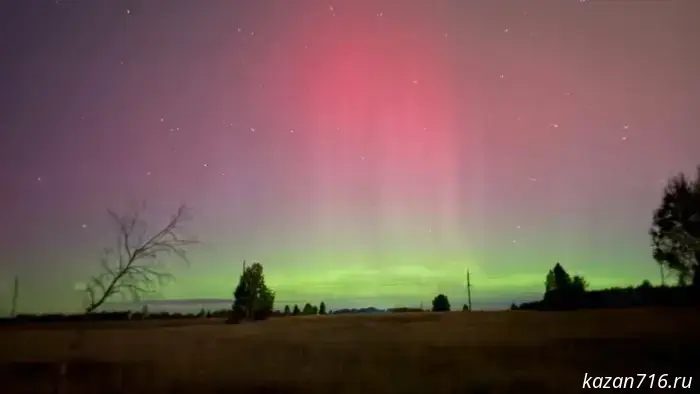
"It's hard to survive a collision with one": drivers were reminded how to avoid an accident involving a moose.
Since the beginning of this year, 12 traffic accidents involving moose have occurred on the republic’s roads; 2 people have died and 13 have sustained various injuries.
Moose are increasingly coming onto the republic’s roads — this is very dangerous both for drivers and for the animals themselves. It is precisely at the beginning of autumn that moose enter the rutting season, and therefore they willingly travel long distances. How not to get into such an accident, read in the report by "Tatar-inform".
"Of all animals, the moose poses the greatest danger to drivers"
In Tatarstan, moose are in rut — the animals have entered their mating season. At this time, experts say, they become most active and travel long distances in search of females. As a result, moose often run out onto roads, and drivers need to be especially attentive.
According to the Traffic Police of Tatarstan, since the beginning of this year there have been 12 traffic accidents with moose on the republic’s roads; 2 people have died and 13 have sustained various injuries.
"The rut is already in full swing now and will continue until the beginning of October. The moose are at their most active at this time, especially the males. Moose generally move little, mostly concentrating in particular areas where there are feeding grounds and consuming vegetation there. That is their way of life, but from late August to September they increase their activity due to a hormonal surge and begin to move in search of a female," Rinat Chispiyakov, head of the Department for the Protection of the Animal and Plant World of the State Committee of the Republic of Tatarstan for Bioresources, told "Tatar-inform."
He noted that during the mating season moose can display aggression and come out onto roads that pass through forested areas.
Rinat Chispiyakov: "You should always be prepared for any animal to run out onto the road"
Photo: © Ramil Gali / "Tatar-inform"
"In Tatarstan we have a well-developed road network. Good roads, and many more cars. But we must not forget that the moose population in Tatarstan is also sizable. Across Russia there is a trend toward an increase in ungulate populations — both moose and roe deer. Therefore, drivers on the roads must be especially attentive during this period. You should always be ready for any animal to run out onto the road," he added.
A moose on the road is dangerous not only for itself but also for drivers. Of all animals it is perhaps the most dangerous — it has long legs and a heavy body topped by a head crowned with powerful antlers. This makes it especially dangerous for passengers and drivers. On impact, the heavy carcass of a moose often breaks through the windshield and flies into the cabin.
"You must be particularly careful at night near forested areas, when the animals are most active. We are petitioning for the installation of warning signs in places where accidents with animals occur. Such signs are installed almost everywhere," Rinat Chispiyakov said.
Most drivers believe that the likelihood of encountering a moose on the road is minimal and that nothing like that could happen to them. But the statistics are merciless.
According to the Traffic Police of Tatarstan, on September 13 in the Almetyevsk district of Tatarstan the driver of a UAZ vehicle failed to choose a safe speed and ran over a moose. The animal died on the spot; the driver later died in hospital from injuries sustained in the accident.
On September 13 in the Almetyevsk district of Tatarstan the driver of a UAZ vehicle failed to choose a safe speed and ran over a moose
Photo: © Traffic Police of the RT
"Even if the animal is only slightly hit, it’s better not to approach it"
Rinat Chispiyakov explained that if an accident with an animal does occur, it is necessary first to provide assistance to people. You must call the traffic police to the scene, and they will notify the district officer of the Department for the Protection of the Animal and Plant World of the State Committee of the Republic of Tatarstan for Bioresources.
"Our officer will arrive at the scene, draw up the necessary documents. Veterinarians will arrive and provide assistance to the struck animal. After such an accident the driver will have to compensate for the damage; insurance companies handle this. The fine for killing a moose is 80,000 rubles. Unfortunately, in 90 percent of cases, accidents with moose are fatal for the animal. But if the driver has only slightly struck the animal, it is still better not to approach it, as it is in a state of shock and may attack," Rinat Chispiyakov concluded.
In February of this year in the Almetyevsk district a moose died after being hit by a car. Drivers reported on social media that the moose lay on the road for several hours after the collision. After receiving the message about the accident, employees of the State Committee of the Republic of Tatarstan for Bioresources arrived on the scene together with the district veterinarian. Unfortunately, they were unable to save the injured moose — the animal died from its injuries.
Rosavtodor has prepared several recommendations for drivers on how to avoid accidents with animals and, if possible, help them. Mostly animals and birds appear in front of a vehicle suddenly, so it is very important to observe the speed limit.
If forest runs right up to the roadway, it is best to drive no faster than 70–80 km/h, even if signs allow higher speeds.
It is best to pass large animals, such as moose or deer, from behind. This greatly reduces the risk that the animal will be frightened and try to attack the car.
Do not try to scare the animal away by flashing headlights or honking: blinded or frightened, it may become unpredictable.
According to traffic rules, when a danger arises on the road the driver must reduce speed up to a stop. This also applies to encounters with animals. If the driver decides to perform an evasive maneuver instead of stopping and this leads to an accident, responsibility for it will rest with the driver. An evasive maneuver makes sense only when the distance to the suddenly appearing animal is too small and braking is no longer possible.
Under no circumstances should you take a struck wild animal away with you — you may be fined for illegal hunting!
You should also not try to move the animal off the roadway yourself. However, if it is injured and needs help, you should move it to the roadside if possible and call specialists who can save it.
This is especially true of owls, which often sit on the road to rest and as a result get injured.
A moose on the road is dangerous not only for itself but also for drivers
Photo: © Igor Zarembo / RIA Novosti
What penalties are imposed for a hit animal?
According to clause 1.2 of the traffic rules, animals are not classified as road users, which does not prevent them from being participants in road traffic accidents. All the grounds specified in that same clause apply. Fines for hitting an animal start at 100 rubles for small species and reach up to 180,000 rubles — for example, for a wisent-bison hybrid and domestic cattle.
Consequences of hitting an animal can include:
- death or injury to people (imagine a collision with a large animal);
- damage to the vehicle;
- other material damage.
If the animal is domestic, the damage is caused to its owner; if it is wild — then to the state. Article 4 of the Law "On the Animal World" states: "The animal world within the territory of the Russian Federation is state property."
Since hitting an animal is recognized as a traffic accident, the driver has no right to leave the scene. Otherwise he faces "deprivation of the right to drive vehicles for a period of one to one and a half years or administrative arrest for up to fifteen days."
In turn, payment of a fine or compensation for an animal is regulated by the Civil Code: "Legal entities and citizens whose activities are associated with increased danger to others (use of vehicles...), are obliged to compensate for harm caused by a source of increased danger..."
Hitting an animal is recognized as a traffic accident; the driver has no right to leave the scene
Photo: © Salavat Kamaletdinov / "Tatar-inform"
The amount of the fine for a struck animal is given in the appendix to the order of the Ministry of Natural Resources:
- Wisent-bison hybrid, domestic cattle — 180,000 rubles
- Snow sheep — 100,000 rubles
- Moose, Siberian ibex, muskox — 80,000 rubles
- Red deer — 70,000 rubles
- Bears, sika deer, fallow deer, turs (Caucasian tur), saiga, musk deer — 60,000 rubles
- Roe deer, mouflon, chamois, lynx — 40,000 rubles
- Wild boar, wild reindeer — 30,000 rubles
- Sable, otter, wolverine — 15,000 rubles
- Badger — 12,000 rubles
- Marmots, beavers, martens, marza (stone marten), capercaillie — 6,000 rubles
- Black grouse, pheasants, ular (a local bird), sadzha (local bird) — 2,000 rubles
- Arctic fox, corsac fox, wild cats, minks, hares, wild rabbit, geese, barnacle goose — 1,000 rubles
- Ducks, hazel grouse, partridges, chukar, pigeons, coot, woodcock — 600 rubles
- Ermine, polecat, weasel, muskrat, khoria (a small mustelid), kolonok (kolonok), squirrels, chipmunks, flying squirrel — 500 rubles
- Wolf, fox, jackal, raccoon dog, raccoon-like dog, quail, rails, common tern (pogonish?), corncrake, reed warbler, lapwing, tules (?), hrustan (?), kamenesharka (?), turukhtan (?), travnik (?), ulita (?), morodunka (?), veretenniki (?), kronshnepy (?), snipe, dupeya (?), garshnep (?), turtle doves — 200 rubles
- Moles, water voles, hamsters, ground squirrels — 100 rubles
If the driver has hit an animal that is listed in the federal or regional Red Book, then that same Ministry of Natural Resources order No. 612 introduces the following coefficients: you will have to pay 5 times more for a struck male and 7 times more for a struck female.
The Traffic Police of Tatarstan remind drivers of the algorithm of actions after hitting an animal. You should turn on the hazard lights and mark the scene with a warning triangle (15 m from the vehicle within a populated area, and 30 m outside it). Then call 112 and summon traffic police and medical personnel if there are injured people. Record everything with photos and video.
You must document the damage to the vehicle, the animal, the road with markings, signs and surrounding landscape. Do not move the vehicle until the traffic police arrive, and it is better not to approach the animal yourself, especially if it is large.
More details: https://www.tatar-inform.ru/news/stolknuvsis-s-nim-vyzit-slozno-voditelyam-napomnili-kak-ne-popast-v-dtp-s-losem-6000643
Photo: Salavat Kamaletdinov
Другие Новости Казани (Казань716)
 Durov explained the meaning of the meme about two chairs.
Durov explained the meaning of the meme about two chairs
Durov explained the meaning of the meme about two chairs. 01.10.2025. Komsomolskaya Pravda Kazan. Republic of Tatarstan. Kazan.
Durov explained the meaning of the meme about two chairs.
Durov explained the meaning of the meme about two chairs
Durov explained the meaning of the meme about two chairs. 01.10.2025. Komsomolskaya Pravda Kazan. Republic of Tatarstan. Kazan.
 The Ministry of Digital Development confirmed an increase in insurance contributions for IT companies and the abolition of VAT on domestic software.
"The industry is firmly on its feet and able to withstand a reduction in benefits," Shadaev is confident.
Photo: 30.09.2025. Real Time. Republic of Tatarstan. Kazan.
The Ministry of Digital Development confirmed an increase in insurance contributions for IT companies and the abolition of VAT on domestic software.
"The industry is firmly on its feet and able to withstand a reduction in benefits," Shadaev is confident.
Photo: 30.09.2025. Real Time. Republic of Tatarstan. Kazan.
 Residents of Tatarstan shared footage of the Northern Lights.
Residents of Tatarstan and neighboring districts of the Volga Federal District witnessed the Northern Lights. 30.09.2025. GTRK Tatarstan. Republic of Tatarstan. Kazan.
Residents of Tatarstan shared footage of the Northern Lights.
Residents of Tatarstan and neighboring districts of the Volga Federal District witnessed the Northern Lights. 30.09.2025. GTRK Tatarstan. Republic of Tatarstan. Kazan.
 Rubin lost to Zenit in a Russian Cup match.
"Rubin" lost narrowly to "Zenit" (0:1) in the fifth-round match of the Russian Cup's RPL path. 30.09.2025. Tatar-inform News Agency. Republic of Tatarstan. Kazan.
At the request of the Prosecutor's Office of Naberezhnye Chelny, the chief administrative officer of the city's Executive Committee was dismissed for loss of confidence.
At the request of the Naberezhnye Chelny City Prosecutor's Office, the manager of affairs of the City Executive Committee — head of the General Department, Albert Ismagilov, was dismissed due to loss of confidence. September 30, 2025. Prosecutor's Office of the Republic of Tatarstan. Republic of Tatarstan. Kazan.
Rubin lost to Zenit in a Russian Cup match.
"Rubin" lost narrowly to "Zenit" (0:1) in the fifth-round match of the Russian Cup's RPL path. 30.09.2025. Tatar-inform News Agency. Republic of Tatarstan. Kazan.
At the request of the Prosecutor's Office of Naberezhnye Chelny, the chief administrative officer of the city's Executive Committee was dismissed for loss of confidence.
At the request of the Naberezhnye Chelny City Prosecutor's Office, the manager of affairs of the City Executive Committee — head of the General Department, Albert Ismagilov, was dismissed due to loss of confidence. September 30, 2025. Prosecutor's Office of the Republic of Tatarstan. Republic of Tatarstan. Kazan.
"It's hard to survive a collision with one": drivers were reminded how to avoid an accident involving a moose.
Since the beginning of this year, 12 traffic accidents involving moose have occurred on the republic's roads; 2 people have died and 13 people have sustained various injuries. 30.09.2025. Zelenodolsk News. Republic of Tatarstan. Zelenodolsk.
